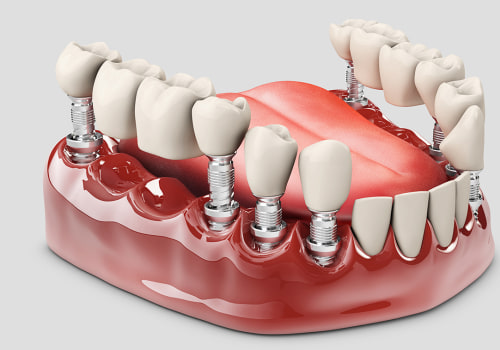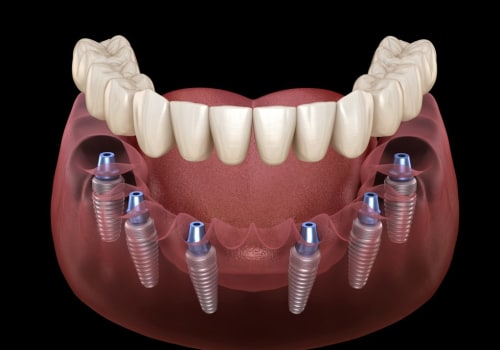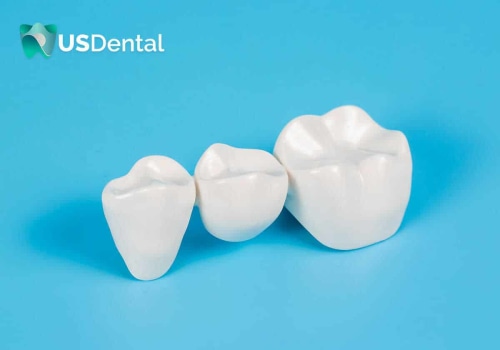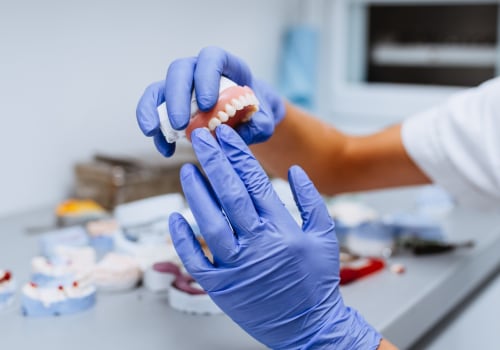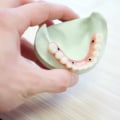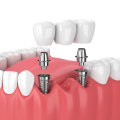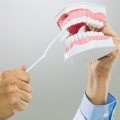In the world of dentistry, partial dentures are a common solution for patients who have lost some of their natural teeth. However, as time goes by, these dentures can become ill-fitting and uncomfortable for the wearer. This can lead to various issues such as difficulty in chewing and speaking, discomfort, and even embarrassment. But fear not, because there are ways to improve the fit and function of existing partial dentures, and in this article, we will explore one specific case study that showcases the effectiveness of this approach.
We will dive into the details of how this treatment method works, the before-and-after results, and the impact it can have on a patient's quality of life. So if you or someone you know is struggling with uncomfortable partial dentures, keep reading to learn more about this proven solution. Partial dentures are a common and effective solution for those who are missing some of their teeth. However, as with any dental appliance, they can come with their own set of issues. If you are struggling with ill-fitting or uncomfortable partial dentures, know that you are not alone.
In this article, we will discuss the most common problems associated with partial dentures and provide solutions to improve their fit and function. One of the most common issues with partial dentures is discomfort. This can be caused by a variety of factors, such as the dentures rubbing against the gums or not fitting properly. This can lead to irritation, soreness, and even pain. Another issue is slipping or movement of the dentures while speaking or eating, which can be embarrassing and uncomfortable.
Lastly, many people struggle with difficulty eating while wearing partial dentures, as they may feel unstable or loose. The good news is that there are several solutions available to address these issues. The first step is to visit your dentist for an adjustment of the fit. Over time, as the shape of your mouth changes, your partial dentures may need to be adjusted to ensure a comfortable fit. This is a quick and easy fix that can greatly improve your overall experience with partial dentures. In addition to adjustments, using adhesive can also help improve the fit and function of partial dentures.
Adhesives come in various forms, such as powders, creams, and strips, and can provide extra stability and support for your dentures. Be sure to follow the instructions provided by your dentist or the manufacturer when using adhesive to avoid any potential issues. For those who are looking for a more permanent solution, implant-supported dentures may be the answer. This involves placing dental implants into the jawbone and attaching the dentures to them. This not only provides a more secure fit but also prevents bone loss in the jaw, which can occur with traditional partial dentures. It is important to note that regular maintenance and check-ups are crucial for the proper function and fit of partial dentures.
Your dentist can identify any issues early on and make necessary adjustments to ensure your dentures continue to fit comfortably. They can also provide tips and advice on how to properly care for your dentures at home. While these solutions may seem daunting or expensive, there are ways to make the process easier and more affordable. Many dental insurance plans cover the cost of adjustments and check-ups for partial dentures, and some may even cover a portion of the cost for implant-supported dentures. Additionally, there are options for financing or payment plans available at most dental offices. Lastly, we understand that there may be objections or concerns about pursuing these solutions.
However, it is important to remember that the discomfort and frustration associated with ill-fitting partial dentures can greatly impact your daily life. By addressing these issues, you can improve your confidence, comfort, and overall well-being. In conclusion, if you are struggling with the fit and function of your existing partial dentures, know that there are solutions available to help improve your experience. From simple adjustments to more permanent solutions like implant-supported dentures, there is an option that can work for you. Remember to visit your dentist regularly and communicate any concerns or issues you may be having.
With proper care and maintenance, you can have a comfortable and confident smile with your partial dentures.
Common Problems with Partial Dentures
For many people, partial dentures are a great solution for replacing missing teeth. They can restore the appearance and function of natural teeth, making it easier to eat and speak comfortably. However, as with any dental appliance, there can be some common problems that arise with partial dentures.Ill-Fitting Dentures
One of the most common issues with partial dentures is that they may not fit properly in the mouth. This can lead to discomfort, difficulty chewing, and even sores or irritation on the gums.Ill-fitting dentures can also cause embarrassing clicking or slipping noises when talking or eating.
Loose or Unstable Dentures
In addition to not fitting properly, partial dentures may also become loose or unstable over time. This can be due to changes in the jawbone or gum tissue, which can occur naturally with age or as a result of tooth loss. Loose dentures can make it challenging to eat certain foods and may cause embarrassment or self-consciousness.Bone Loss
When teeth are missing, the jawbone can begin to deteriorate due to lack of stimulation from chewing and biting. This can result in a sunken appearance of the face and make it difficult for dentures to stay in place.It is important to address bone loss early on to prevent further complications.
Difficulty Speaking
Partial dentures can also affect speech, especially if they are ill-fitting or loose. The tongue may have difficulty adapting to the new appliance, causing slurred or altered speech. This can be frustrating and impact one's confidence when communicating.Poor Aesthetics
In some cases, partial dentures may not look as natural or aesthetically pleasing as desired. This can be due to incorrect size or shape of the dentures, improper placement in the mouth, or discoloration over time.Poor aesthetics can make one feel self-conscious and hesitant to smile. Understanding these common problems with partial dentures is the first step in finding a solution. In the next section, we will discuss ways to improve the fit and function of existing partial dentures.
Maintenance and Check-Ups
One of the key factors in ensuring the fit and function of your existing partial dentures is to properly maintain and regularly check them. This not only helps to extend the lifespan of your dentures, but also prevents any potential problems or discomfort.Brushing
your dentures is just as important as brushing your natural teeth. Use a soft-bristled toothbrush and a non-abrasive denture cleaner to gently clean all surfaces of your dentures.Be sure to remove any food particles or plaque buildup.
Soaking
your dentures in a denture cleaning solution can help to remove stubborn stains and bacteria. Follow the instructions on the cleaner for the recommended soaking time.Rinsing
your dentures after each meal is also crucial in maintaining their cleanliness and preventing any buildup. Be sure to use lukewarm water and avoid hot water as it can cause warping.Regular Check-Ups
with your dentist are necessary to ensure the fit and function of your partial dentures. Your dentist will be able to spot any potential issues and make adjustments or repairs as needed.They will also be able to provide guidance on proper cleaning and maintenance techniques.
Adjusting the Fit
One of the main reasons for ill-fitting partial dentures is improper adjustment. This can be caused by a variety of factors such as changes in the shape of the jaw, natural wear and tear of the dentures, or even poor initial fitting. Whatever the cause may be, it's important to address it in order to achieve a more comfortable fit.Here are some tips for adjusting the fit of your partial dentures:
- Regularly visit your dentist for adjustments - Your dentist will be able to identify and fix any issues with your partial dentures. It's important to schedule regular check-ups to ensure that your dentures are fitting properly.
- Use a denture adhesive - If your dentures feel loose, a denture adhesive can help improve their fit.
This can also help prevent any discomfort or irritation caused by rubbing.
- Try over-the-counter cushioning products - There are various over-the-counter products available that can help improve the fit of your partial dentures. These include cushioning pads or strips that can be placed on areas that are causing discomfort.
- Consider getting a reline - If your dentures are too loose or uncomfortable, your dentist may recommend a reline. This involves adding new material to the base of the denture to better fit your gums.
Considering Implant-Supported Dentures
Implant-supported dentures have become a popular option for those looking for a more permanent solution to their partial denture woes. Unlike traditional partial dentures, which are held in place by clasps or adhesive, implant-supported dentures are anchored to dental implants that are surgically placed in the jawbone. This provides a much more secure and stable fit, eliminating the need for messy adhesives and uncomfortable clasps. In addition to improving the fit and function of your existing partial dentures, implant-supported dentures also offer other benefits.They help preserve the jawbone, preventing bone loss that can occur with traditional dentures. This not only maintains facial structure and appearance, but also supports the surrounding natural teeth. Implant-supported dentures also allow for a more natural chewing and speaking experience, as they do not shift or move like traditional dentures can. This can greatly improve overall comfort and confidence. If you are considering implant-supported dentures as a solution for your ill-fitting or uncomfortable partial dentures, it is important to consult with a qualified dentist. They will be able to evaluate your specific needs and determine if you are a good candidate for this procedure. Overall, implant-supported dentures offer a more permanent solution for those struggling with partial dentures.
With their many benefits, they are definitely worth considering for a more comfortable and confident smile.
Using Adhesive
One of the most common issues with partial dentures is the constant slipping and shifting, causing discomfort and embarrassment for the wearer. Fortunately, there are ways to improve the fit and stability of your dentures, and one of the most effective methods is by using adhesive.What is denture adhesive?
Denture adhesive is a type of cream or paste that is applied to the surface of your dentures before placing them in your mouth. It acts as a bonding agent between your dentures and gums, creating a more secure fit.How to apply denture adhesive? The first step in using adhesive for your partial dentures is to make sure they are clean and dry. Any debris or moisture on the surface can prevent the adhesive from working effectively. Next, apply a small amount of adhesive along the surface of your dentures. Be careful not to use too much, as it can cause excess seepage and discomfort.
How often should you use denture adhesive? The frequency of using denture adhesive may vary depending on the individual's needs. Some may only need to use it once a day, while others may need to reapply after meals or snacks. It's important to follow the instructions on the product and adjust according to your personal experience.
Tips for using denture adhesive
- Start with a small amount and add more if needed.
- Clean your dentures thoroughly before reapplying adhesive.
- If you experience any discomfort or irritation, consult with your dentist for alternative options.
Don't let discomfort or slipping dentures hold you back from enjoying your favorite foods or smiling confidently. Remember to also schedule regular check-ups with your dentist to ensure your dentures continue to fit properly.
